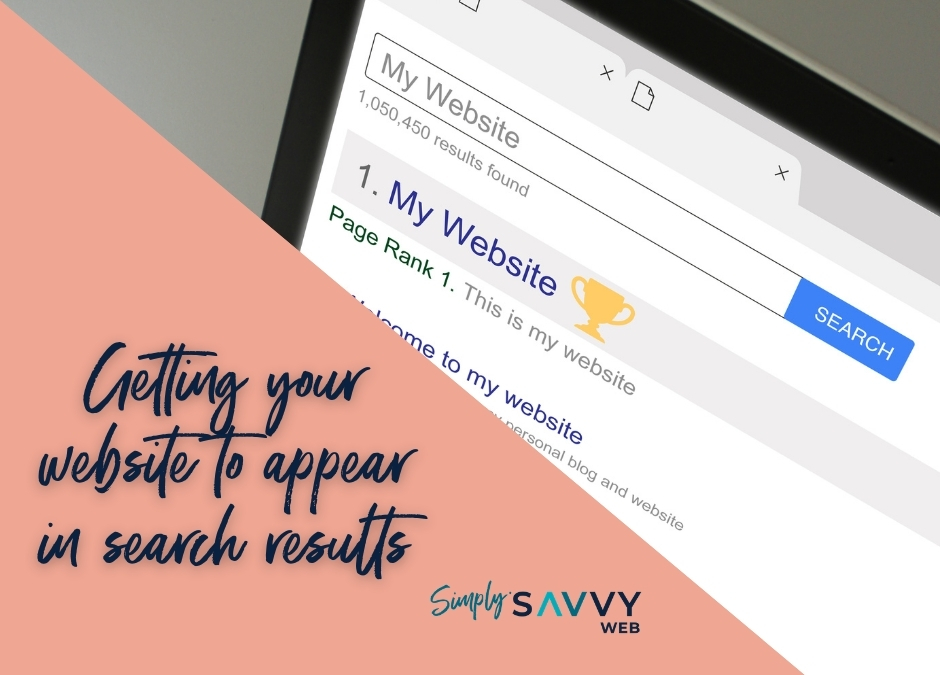Let’s talk about getting your website found online
>> Part Five in the series The Top 5 Things You Need To Launch Your Website and Get Found Online (here’s the initial overview post in case you missed it).
Ok, so you have your website set up, great!
But, are you getting found online?
In this post, we’ll go into at what Google looks for when ranking your website, explain in simple terms just what does ‘SEO’ mean, how to find keywords to use, and how long you can expect it to take to see results.
How do you rank?
Google algorithms for indexing and ranking websites are constantly changing, and Google keeps the details of those algorithms under very tight wraps. In the past, SEO ‘experts’ have tried to influence rankings with various methods referred to as ‘black hat’; these tactics do not work any more, and in fact, Google will penalise sites using such methods.
There is no magic bullet, or ‘getting you on the top of search results in 30 days’. It takes time and consistent action.
There are many factors that go into search ranking, but in a nutshell, Google looks for three main things, and these should be the basis of your strategy:
- good quality, relevant content on your website
- good user experience on your website
- good quality, relevant links to your site from other relevant sites
I’m sure you’ve all heard of SEO, but what exactly is it?
What is SEO?
There are things that you can do on the website itself (on-page), and other things that are done using other websites (off-page).
On-Page SEO factors
This includes all those things in the first two points above (good quality, relevant content and good user experience), plus some technical components.
Content is a whole topic on its own, but basically it needs to –
- Be written first and foremost for the user – make sure it’s relevant and easy to read
- Keep Google in mind, using relevant keywords, 300-500 words minimum per page, plus a few other things which I’ll mention below
Providing a great user experience on your website includes –
- Being optimised for mobile
- Fast page load speed
- Use of an SSL certificate to assure security
- Appropriate website structure with easy navigation, i.e. use the ‘3 click rule’ (they should be able to find what they need with no more than 3 clicks)
Other on-page aspects – use a plugin such as Yoast SEO or SEOPress to help you with the following –
- Meta titles and descriptions (these are what show in search results)
- Optimised images – sized for purpose, compressed for small file size (< 200KB), filename with keywords (before uploading), use of ‘alt’ tags (accessibility factor)
- Using keywords in page names (URL), headings, and within content
- Links, both internal (between your pages) and external (to other authoritative sites)
Off-Page SEO
The aim of off-page SEO is to build links to your website from other websites (aka ‘backlinking’). This tells Google that your site is authoritative and trusted. But you can’t just build links from any old website – they must be authoritative, relevant to your website, and trusted as well.
Off-page links can include:
- Directory listings –
- General sites like Yellow Pages and Yelp
- Sites specific to your industry
- Other business listing or membership sites
- Google My Business page
- Guest posting –
- Writing blogs or articles to be published on relevant, trusted industry sites, linking back to your own website
Other digital and traditional marketing, such as social media and offline advertising, can add to your brand recognition which will also help you to get found online. Having a Google My Business page is essential, and asking for Google reviews whenever you can will go a long way too.

Finding your key words
Your keywords are based on the words and phrases that your visitors are using to find what it is that you offer. Therefore you need to make sure you’re using those keywords throughout your content – but naturally, in a way that makes sense.
Google will then index those words on your site, and when people search using those words, your site may appear in the search results. We’ll discuss some things that determine where in the search results your site may appear, and when, below.
But firstly let’s look at how you can find the best keywords to use.
Good SEO starts with keyword research and knowing what it is that your customers are searching for. The first thing to do is brainstorm what phrases you think people will be using when they’re searching for your products or services. Then from there, you can use a keyword research tool to get some ideas of what people are actually using when they’re searching.
Our top two keyword planning tools are Google Keyword Planner, and Ubersuggest by Neil Patel. You type in the search terms that you think that your customers will be looking for and then it will give you some suggestions of what they are using. It will also show things like monthly search volume and keyword difficulty.
How long does it take for your website to show on page one of Google?
As a general (very general!) guideline, and depending on a number of factors, you could expect to see improvement in your website ranking in around three to six months.
If you’re starting a brand new website and a brand new domain, it takes time for your keywords to take effect. How competitive your keywords are plays a big part. If you’re in a very competitive industry, for example something highly competitive like ‘weight loss’, it’s going to take longer, and a lot more effort, to rank.
Next, the location. If you’re targeting a local market – a town or suburb, rather than a large capital city – it should be quicker and easier. If you’re targeting a regional, national or global market, it gets a lot more competitive and will take a lot more time and effort (and $$$).
Keeping track of your results
Lastly, when you are working on your search engine optimisation, you need to be measuring the results. There are free tools that can help you measure and track where you’re going and see what is working and what isn’t. Take a look at Google Analytics and Google Search Console.
You can see results such as where your visitors are coming from, what pages they visit, and how long they spend on the page, using Google Analytics. With Search Console, you can also see what queries people have used and how often those search terms have appeared in search results, and how many times people have clicked on them.
Pro tip: When you set up an account, make sure you get the Google Analytics tracking code and install that on your website; this little code is genius in keeping track of everything for you! If your theme doesn’t provide a spot for you to add the code, you can use a plugin such as Insert Headers and Footers.
Need more help?
I hope this post has given you some helpful pointers about getting your website ranking in search results and found by your customers!. If you have more questions or need any help, you can get in touch with me either on my contact page or my Facebook page.
You can also view my video on this topic on my YouTube channel.
Next steps…
This was the final post in the 5-part series The Top 5 Things You Need To Launch Your Website and Get Found Online.
Why not join my Website DIYers Hub below for more great tips and tutorials to help you get better results from your website.
You can also join my VIP Waitlist to be the first to hear about Website Jumpstart – a step-by-step system to creating a beautiful website that gets results – coming in January 2021!
>> Have you joined my Website DIYers Hub yet? <<
This is a friendly place to interact and get support, feedback and encouragement, helping you to:
- Feel less stuck, more confident, and more in control
- Learn about ways to improve your website along with problem-solving tips and short tutorials
- Get online, get found, and get web savvy!
As a website coach for micro-business owners, I am here to help you with getting online and learning how to create, update and get better results from your WordPress website.

